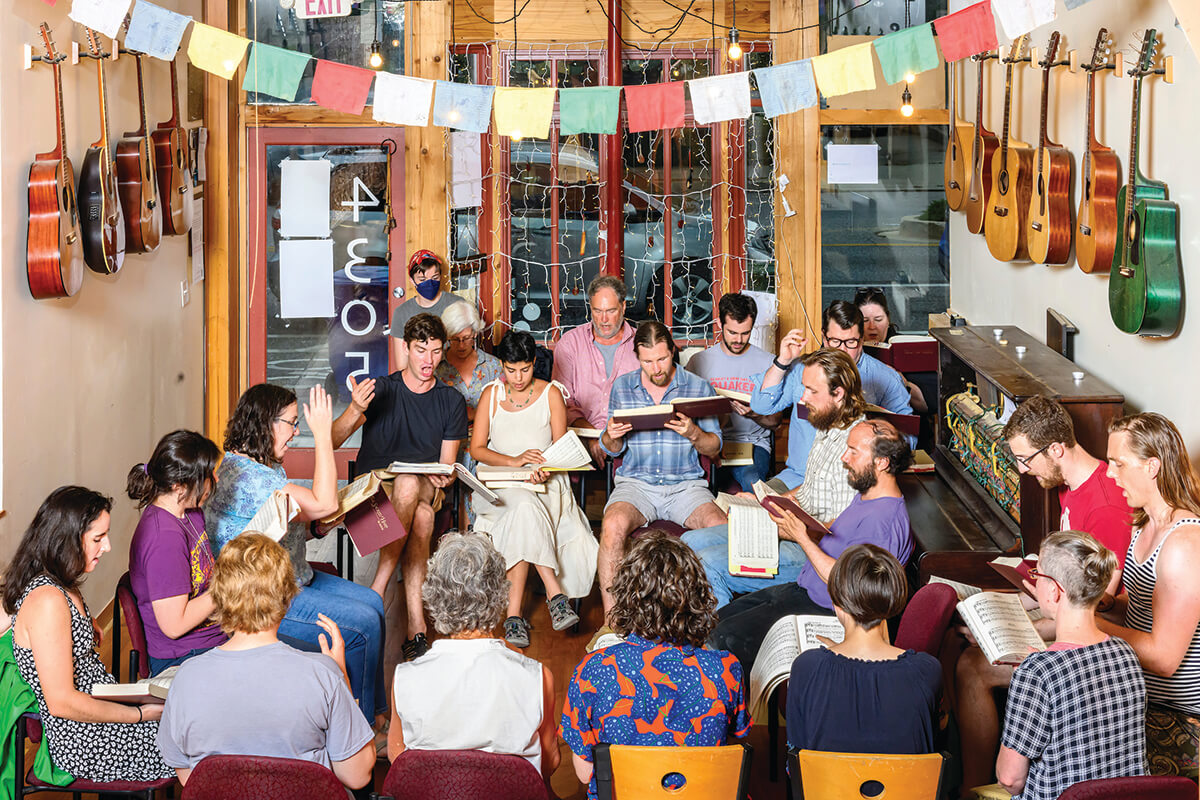Arts & Culture
Awake Thy Soul: Singing the Centuries-Old ‘Sacred Harp’ in Baltimore
Developed in the late 1700s and early 1800s, shape-note singing soon moved south and west along with the frontier.

Inside the warm, front-room performance space at Four Hour Day Lutherie, Nora Miller raises and lowers her right arm to keep time.
Around her, two dozen singers—there are tenor, bass, alto, and treble sections—sit and face each other in what’s called the “hollow square” in the distinctly American hymnal tradition known as shape-note singing. They hold a songbook, The Sacred Harp, first printed in 1841.
And let this feeble body fail, And let it faint or die; My soul shall quit this mournful vale, And soar to worlds on high. (chorus) And I’ll sing hallelujah, And you’ll sing hallelujah, And we’ll sing halleujah, When we arrive at home.
In college in upstate New York, Miller had participated in choir for a semester. But that was the end of her musical life until someone in her long-standing Dungeons & Dragons game mentioned her shape-note singing group a couple of times in random conversation.
“No one gave it a second thought until that movie Cold Mountain came out and she was like, ‘I gotta go to L.A. and do all this stuff for the Oscars and we were like, ‘What? What are you talking about?’”
The Civil War-period film, which won the Academy Award for Best Original Music, featured characters played by Nicole Kidman and Jude Law singing hymns in the shape-note tradition in their North Carolina church. Miller’s friend performed in the choir at the award show.
“So we paid a little bit more attention to what this singing was and I saw the movie and thought, ‘Oh, this looks kind of fun,’ and she took me to a singing. From day one, I was hooked.”
Fast forward two decades. Miller, with assistance from her husband, Joel, leads the last Thursday of every month a cappella (“in the style of the chapel,” in Italian) shape-note sing at Four Hour Day Lutherie. Considered a bit of a subculture perhaps today—participants and venues naturally change over time, not unlike in, say, the D&D world—shape-note singing has a steeped history. Some believe the shape-note singing in Protestant colonial New England churches to be the first “popular” and oldest written music in the U.S.
The shape-note method, designed to teach non-music reading congregants how to sight-sing Christian hymns together (and fill the pews), first appeared in 1801 in a book called The Easy Instructor.
As still performed today, it uses four syllables to cover the seven notes of the scale and gives each a distinctive sheet notation: a triangle for fa, an oval for sol, a rectangle for la, and a diamond for mi. Developed in the late 17th century, shape-note singing soon moved south and west along the frontier.
Raucous at times, haunting at others, shape-note singing can come across as an indecipherable wall of sound at first because of its polyphonic harmony singing. It is intended for participation, not for audiences or recording. It is also an undeniably communal, and often transcendent, experience, according to practitioners.
Sometimes called “sacred harp” singing after the enduring songbook—the term is a nod to the human voice—it remains an unbroken tradition in parts of the South. The two oldest surviving shape-note singing conventions are the Chattahoochee Musical Convention, founded in Georgia in 1852, and the East Texas Sacred Harp Convention, which began in 1855.
Meanwhile, since the release of Cold Mountain in 2003 and the excellent if limited-distribution documentary, Awake My Soul: The Story of the Sacred Harp, in 2006, more people across the country have become aware of the tradition.
There were all-day singings in Washington, D.C., and Berryville, Virginia, this spring, for example. Philadelphia hosts regular sings. A new group is starting in Easton, Maryland. Groups have also popped up in Germany, England, Ireland, France, Canada, Poland, and the Netherlands.
Given that church attendance continues to wither, it’s a compelling phenomenon that many—and all are welcome—are finding fellowship and meaning in singing the old hymns.
“I would not call myself any particular religion at this point, and maybe it’s a little much, but I don’t think you can sing these words and not have a spiritual experience,” says Miller, a Baltimore school teacher, who was raised Catholic. “If you don’t believe the stories in the Bible are real, there’s still this way that they are symbolic and that humans are trying to explain the human experience, right? For me, it’s very much that kind of thing. You can’t pretend bad things aren’t gonna happen to you and we’re not all about to break and headed towards death.
“It’s interesting because some people may take the words literally, as what’s in The Sacred Harp is the word of God. But even as I sit down next to people and we’re looking at these words in different ways, we are probably having a similar experience. That’s pretty cool.”